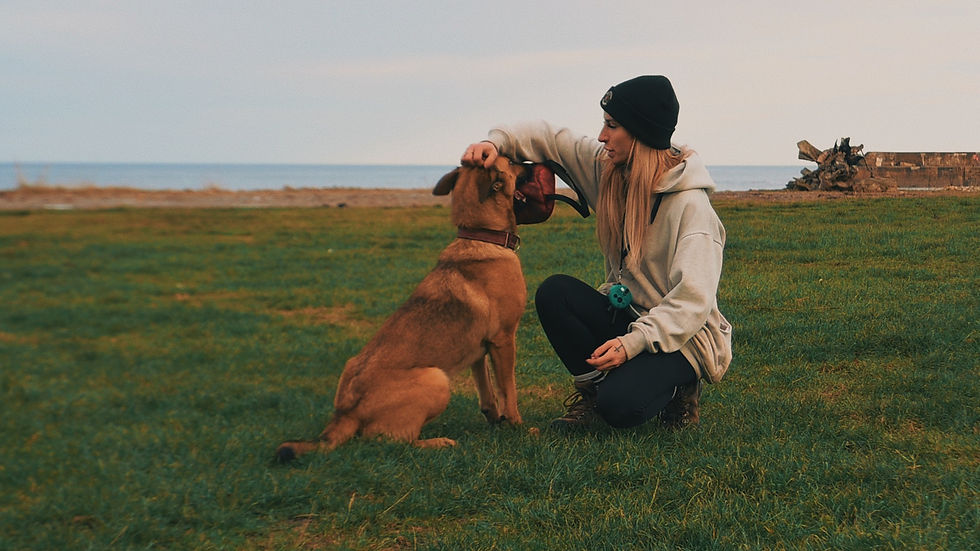What If Your Dog’s Reactivity Isn’t What You Think?
- pawsnclawstraining
- Jul 31
- 3 min read
When we hear the word reactive, most people think of barking, lunging, growling- the “aggressive” behaviour that turns a walk into something stressful or embarrassing. But reactivity in dogs is much more complex than that.
In fact, not all reactivity is aggressive. Some dogs react out of fear. Some out of excitement. Some just don’t know what else to do.
If your dog is struggling to cope in certain environments, pulling to get to dogs or people, barking at movement, or just unable to focus - there’s a reason. And often, it’s not the one we first assume.

Let’s break it down.
Pain - Even If It’s Not Obvious
Dogs are incredibly good at hiding pain.They often don’t show clear signs until things are pretty advanced, and by then, behaviour issues may have already set in.
Pain can cause:
Lower tolerance levels
Increased sensitivity to touch or noise
Sudden changes in behaviour
Seemingly “random” reactivity or outbursts
A dog who suddenly becomes reactive to handling, movement or other dogs may not be “acting out”- they might just be uncomfortable. That’s why pain checks or vet visits should always be part of the process when working with reactivity.
Unmet Needs: Mental and Physical Fulfilment
We can’t expect calm, regulated behaviour from dogs whose needs aren’t being met. And this isn’t just about long walks or off-lead time.
Dogs were bred for a purpose.From scent hounds and spaniels to herders and terriers - they were designed to do something.
When those instincts aren’t given a healthy outlet, frustration builds. And that frustration can come out as overexcitement, barking, or reactive behaviour.
Think about your dog’s breed (or mix of breeds) and what they were originally bred to do:
Scent hounds need space to sniff and track
Collies and shepherds often crave mental structure and direction
Spaniels thrive on purposeful activity and connection
Terriers love to dig, chase, and explore
Fulfilling these needs can be a total game-changer for their behaviour.
Structured outlets like scentwork, trailing, agility-style games, obedience and focused play are a brilliant way to channel that energy and reduce reactivity long-term.
Lack of Motivation or Connection
It’s easy to assume our dogs should just listen.But would you work for free? Dogs need motivation, and it’s our job to make working with us worth it.
If your dog doesn’t see value in staying near you or checking in, they’ll choose the environment instead. That’s when we see lunging, ignoring commands, or reacting instead of responding.
Building a strong working relationship (with rewards that matter to your dog) is essential - and it doesn’t mean bribery. It means making yourself part of the picture again.
Missing Communication
Sometimes, dogs simply don’t know what we want from them.
We might assume they know what “leave it” means- but do they really? We might think they’re being stubborn- but are we being clear?
Reactivity can stem from confusion just as easily as from fear. Helping dogs understand what we do want (rather than just correcting what we don’t) goes a long way in building calmer, more responsive behaviour.
The Bottom Line
Reactivity is a symptom, not a personality trait.Whether it’s fear, pain, frustration or confusion - your dog is trying to communicate something.
Instead of asking “how do I stop this?” Try asking: What is my dog trying to tell me? Where are their needs not being met? Have I ruled out pain or discomfort?
Working with reactivity takes patience, understanding, and often a shift in perspective and that’s okay.
At Paws n Claws, we look at the whole picture: the dog, the environment, the relationship, and what’s really going on beneath the surface.
Need help with your reactive dog?We offer 1-2-1 training and reactivity support tailored to your dog’s needs- with the goal of building calm, confident behaviour for real life.




Comments